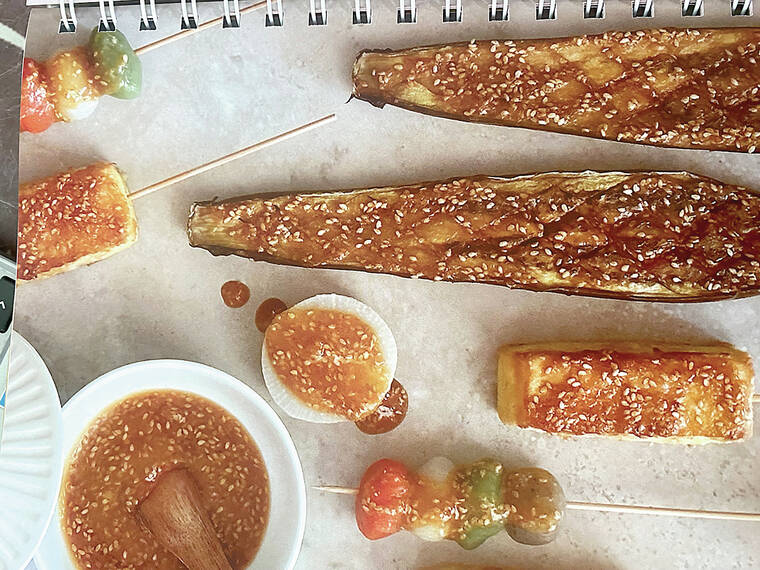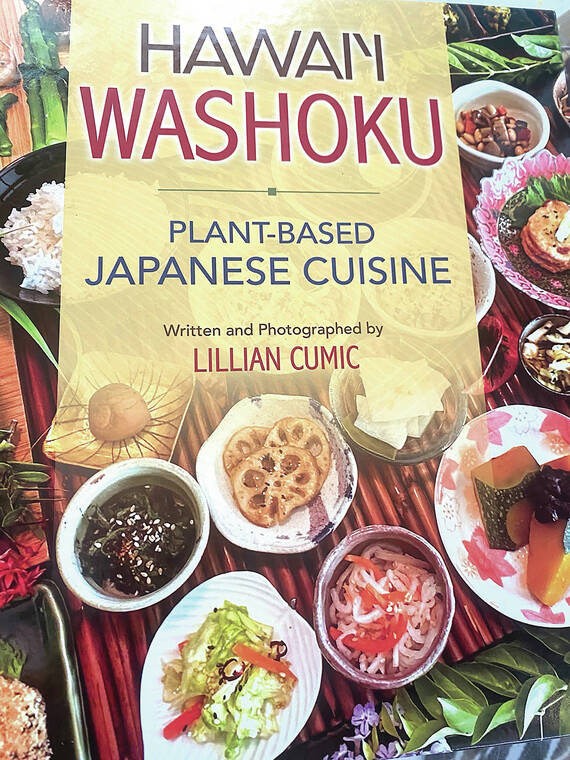Lillian Cumic’s third vegan cookbook, Hawai‘i Washoku, is a collection of over 175 plant-based and gluten-free Japanese washoku recipes.
This style of cooking is based on the Japanese principals of five colors, five flavors, five cooking methods, five senses and five reflections in every meal to bring balance and alignment to the mind, body and spirit.
Goshiki, or five colors, should have aka (red), ao (green), kii (yellow), shiro (white), kuro (black) and umami (savory).
Gomi, or five tastes, should be a balance between amai (sweet), shiokarai (salty), suppai (sour) and nigai (bitter).
The five cooking methods include nama (cut), niru (simmer), musu (steam), yaku (grill) and ageru (fry).
Gokan, or five senses, incorporate sight, sound, smell, touch (referring to the mouthfeel) and taste.
Gokan-mon, or the five reflections, are based on Buddhism and are as follows:
First, to feel appreciation and respect for those who cultivated, harvested, and prepared the food.
Second, to do good deeds worthy of receiving nourishment.
Third, to come to the table free of wrath.
Fourth, to partake of spiritual as well as temporal well-being.
Fifth, to pursue the path of enlightenment.
In 2013, washoku — which means “harmony of food” — was registered in a UNESCO’s Intangible Cultural Heritage, which defines washoku as “a special practice based on a set of skills, knowledge, practice and traditions related to the production, processing, preparation and consumption of food. It is associated with an essential spirit of respect for nature that is closely related to the sustainable use of natural resources.”
Originally from Sydney, Australia, Lillian had lived in Sendai, Japan for 30 years, working in the culinary industry as a head chef and dining bar owner, cooking instructor and a private chef.
Chef Alan Wong says, “The recipes, methods and techniques Lillian share makes vegan Japanese dishes approachable and easy to make at home.”
Chef Sam Choy says, “Mushrooms taste like steak, tofu tastes like chicken, and somehow a bell pepper magically becomes ahi sashimi.”
This miso sauce can be slathered on many grilled vegetables for a vegetarian meal.
Miso Glazed Sauce (Degaku Miso)
Yields 1/2 cup
3 tablespoons red miso
3 tablespoons mirin
3 tablespoons sake
2 tablespoons sugar
2 teaspoons karashi (Japanese mustard)
2 tablespoons toasted white sesame seeds
Whisk the miso, mirin and sake in a saucepan over low heat. Once the mixture is well combined, add the sugar and whisk until it dissolves and the glaze is shiny. Whisk in the karashi, then add the sesame seeds and mix well. Remove from the heat and use immediately or store in an airtight container in the refrigerator for up to three weeks.
Seventy-five percent of Japanese eat miso soup once a day so if you want to dine like they do, make a pot of miso soup for one of your meals.
Miso Soup (Miso Shiru)
Yields 4 servings
Dashi
3 dried shiitake mushrooms, rinsed
4 square inches dried kombu
4 cups water
1 tablespoons kombu dashi granules
Miso Soup
1 aburage (deep-fried tofu)
1/3 block soft tofu, cut into 1/2-inch cubes
2 tablespoons dried wakame
2 tablespoons miso paste, or to taste
Garnish: 2 tablespoons thinly sliced green onions
Soak the shiitake mushrooms and kombu in the water for at least 5 hours or overnight to infuse.
Strain dashi into a pot through a fine mesh strainer or cheesecloth to remove any impurities. Reserve kombu for another use. Rinse shiitake in water to remove any dirt under the caps and around the stem. Cut off stems and discard. Cut shiitake caps into thin slices and add to the dashi with the kombu dashi granules (add vegetables at this point, if using).
Place aburage in a colander and pour boiling water over it to remove the oily flavors. Drain and pat dry. Cut aburage into quarters, then cut each quarter into thin slices. Add to the pot of dashi with the tofu and wakame. Bring soup to a simmer over medium-high heat and cook for 2 minutes. Turn off the heat and mix in the miso using chopsticks and a ladle or small strainer (adjust the amount of miso to taste). Cover the pot and let the soup sit for 1 minute to allow flavors to meld. Ladle into bowls and serve hot, sprinkled with green onions.
Chef’s Notes: Adding vegetables to your miso soup imparts a lot of flavor and nutrients. Try using potatoes, sweet potato, Okinawan potato, carrot, kabocha, daikon, cabbage, enoki and shimeji mushrooms, eggplant or bean sprouts. Cook the vegetables until tender and always add the miso last.
• • •
Hawaii Community College’s Culinary Program Cafeteria is open from 10:30 a.m. until 12:20 p.m. today through Friday. Call the cafeteria at (808) 934-2559 and provide your order, name, phone number and pick up time when placing your order. For Da Ohana Corner Cafe, call (808) 934-2591.
Their annual special Thanksgiving menu will be released on Monday, Oct. 30. As soon as the menu comes out, place your Thanksgiving orders as soon as possible because they sell out every year!
Email Audrey Wilson at audreywilson808@gmail.com.









